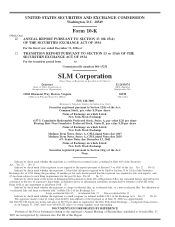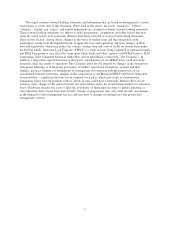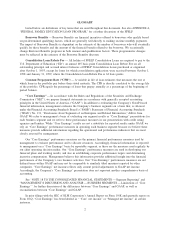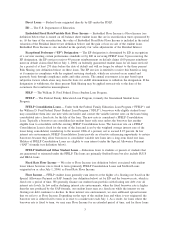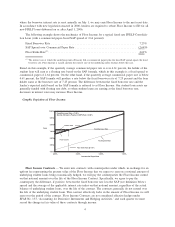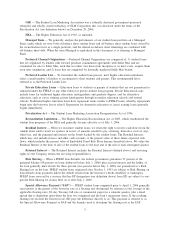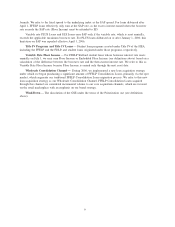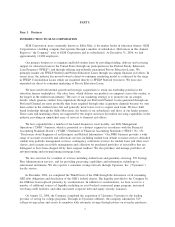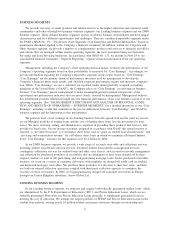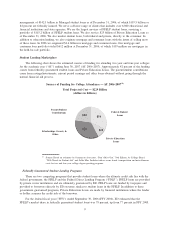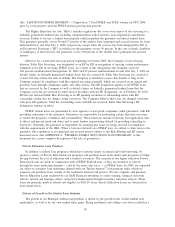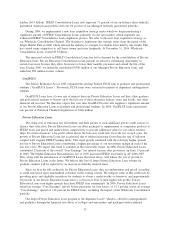Sallie Mae 2006 Annual Report Download - page 4
Download and view the complete annual report
Please find page 4 of the 2006 Sallie Mae annual report below. You can navigate through the pages in the report by either clicking on the pages listed below, or by using the keyword search tool below to find specific information within the annual report.Direct Loans — Student loans originated directly by ED under the FDLP.
ED — The U.S. Department of Education.
Embedded Fixed Rate/Variable Rate Floor Income — Embedded Floor Income is Floor Income (see
definition below) that is earned on off-balance sheet student loans that are in securitization trusts sponsored by
us. At the time of the securitization, the value of Embedded Fixed Rate Floor Income is included in the initial
valuation of the Residual Interest (see definition below) and the gain or loss on sale of the student loans.
Embedded Floor Income is also included in the quarterly fair value adjustments of the Residual Interest.
Exceptional Performer (“EP”) Designation — The EP designation is determined by ED in recognition
of a servicer meeting certain performance standards set by ED in servicing FFELP loans. Upon receiving the
EP designation, the EP servicer receives 99 percent reimbursement on default claims (100 percent reimburse-
ment on default claims filed before July 1, 2006) on federally guaranteed student loans for all loans serviced
for a period of at least 270 days before the date of default and will no longer be subject to the three percent
Risk Sharing (see definition below) on these loans. The EP servicer is entitled to receive this benefit as long
as it remains in compliance with the required servicing standards, which are assessed on an annual and
quarterly basis through compliance audits and other criteria. The annual assessment is in part based upon
subjective factors which alone may form the basis for an ED determination to withdraw the designation. If the
designation is withdrawn, the three percent Risk Sharing may be applied retroactively to the date of the
occurrence that resulted in noncompliance.
FDLP — The William D. Ford Federal Direct Student Loan Program.
FFELP — The Federal Family Education Loan Program, formerly the Guaranteed Student Loan
Program.
FFELP Consolidation Loans — Under both the Federal Family Education Loan Program (“FFELP”) and
the William D. Ford Federal Direct Student Loan Program (“FDLP”), borrowers with eligible student loans
may consolidate them into one note with one lender and convert the variable interest rates on the loans being
consolidated into a fixed rate for the life of the loan. The new note is considered a FFELP Consolidation
Loan. Typically a borrower can consolidate his student loans only once unless the borrower has another
eligible loan to consolidate with the existing FFELP Consolidation Loan. The borrower rate on a FFELP
Consolidation Loan is fixed for the term of the loan and is set by the weighted average interest rate of the
loans being consolidated, rounded up to the nearest 1/8th of a percent, not to exceed 8.25 percent. In low
interest rate environments, FFELP Consolidation Loans provide an attractive refinancing opportunity to certain
borrowers because they allow borrowers to consolidate variable rate loans into a long-term fixed rate loan.
Holders of FFELP Consolidation Loans are eligible to earn interest under the Special Allowance Payment
(“SAP”) formula (see definition below).
FFELP Stafford and Other Student Loans — Education loans to students or parents of students that
are guaranteed or reinsured under the FFELP. The loans are primarily Stafford loans but also include PLUS
and HEAL loans.
Fixed Rate Floor Income — We refer to Floor Income (see definition below) associated with student
loans whose borrower rate is fixed to term (primarily FFELP Consolidation Loans and Stafford Loans
originated on or after July 1, 2006) as Fixed Rate Floor Income.
Floor Income — FFELP student loans generally earn interest at the higher of a floating rate based on the
Special Allowance Payment or SAP formula (see definition below) set by ED and the borrower rate, which is
fixed over a period of time. We generally finance our student loan portfolio with floating rate debt over all
interest rate levels. In low and/or declining interest rate environments, when the fixed borrower rate is higher
than the rate produced by the SAP formula, our student loans earn at a fixed rate while the interest on our
floating rate debt continues to decline. In these interest rate environments, we earn additional spread income
that we refer to as Floor Income. Depending on the type of the student loan and when it was originated, the
borrower rate is either fixed to term or is reset to a market rate each July 1. As a result, for loans where the
borrower rate is fixed to term, we may earn Floor Income for an extended period of time, and for those loans
3

